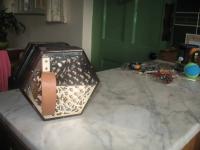-
Posts
199 -
Joined
Posts posted by DDF
-
-
You'll find loads of ozone generators/air purifiers on ebay they are pretty cheap as they are quite simple to make. Regards David.
-
This guys channel is well worth looking through,sorry if its been on here before.David.
-
 1
1
-
-
Have you ever opened up a concertina and wondered how on earth it came to be full of black dust and muck .The answer might be it was this one mentioned by Walter Wilkinson in his 1927 book The Peep Show."By their conversation they were in a gloomy state of mind and they reminded me of a man I once met who always relieved his low spirits by locking himself in a dark coal cellar and playing a concertina for an hour or two".
Walter Wilkinson's 8 books documenting his travels with his puppet show can still be picked up, are all very enjoyable .David.
-
I think the detector works by induction, it does sense aluminium powder and gold metal.
-
That reminded me of something that has been on a shelf in the workshop for years.I just dug it out and took a picture I bought it thinking it was gold but when you put a metal detector/stud detector over it it doesn't register.I just put some in a drop of nitric acid and nothing happened so I guess its mica or goodness knows what.I think it was the box it came in mislead me originally.

-
Try popping it on your kitchen scales then if you depress the key it will show you the pressure you are exerting.
-
On 1/2/2020 at 9:58 PM, SteveS said:
I'm intrigued by these reeds.
Bill, or anyone else here, do you have any practical experience with these reeds?
How do they sound, especially compared to traditional concertina reeds?
Do they have a more accordion sound to them perhaps?
I found the response to be ok but overall the sound of them is a bit disappointing.A little weak and breathy. I would say they are equivalent to a very average set of Lachenal reeds and the sound to be somewhere between accordian and traditional reeds.
-
 1
1
-
-
On 12/28/2019 at 7:29 AM, alex_holden said:
A client told me they have a Dipper instrument with ebony buttons. I've made a couple with boxwood buttons (not as hard as LV but it is very dense). Unfortunately true LV is now endangered and difficult to obtain. I have an antique wooden mallet with a LV head, but any time I use it I feel guilty about using such a rare wood to bash things!
If you fancy trying some there is actually a plentiful supply of LV in old abused crown green bowling balls they used to be about a fiver a piece .A challenging recycling project for sure.
-
21 hours ago, Richard Mellish said:
I'm wondering how the pads are joined to the levers. They appear to be integral, without the flexibility that a conventional concertina has at that point, and therefore relying entirely on the elasticity of the material on the side facing the action plate.
It says somewhere they are attached with a small firm ball joint on the lever ends and they seal very well. David.
-
Here you go,not mine by the way .David
-
Hello,I think you'll find those are two different instruments in your stills.My guess for the one use in the video would be a Wheatstone with wooden ends and nickel buttons? David.
-
If you need 1 mm these people supply small quantities.
-
Superb.I expect you familiar with this one but it always worth another watch.
-
 1
1
-
-
3 hours ago, welsh boi said:
I have tried to post pics but I get a message saying only up to 3.91mb
-
 1
1
-
-
1 hour ago, Robin Harrison said:
Can't easily get it in Canada either................but I'm curious to know about Roger Thomas.
The name is not familiar to me as a concertina repair person.
Robin
Google shows this.
http://www.jollyrogeraccordions.co.uk/
-
This should help clear up the name pronunciation and is a delightful watch as well. David.
-
I have 9008 Geoff kindly told me it was made by H T Crabb in 1927. David.
-
34 minutes ago, John Dipper said:
Anyone know why The attachment is no longer viewable?
It opened ok for me @9.25 am,thank you.
-
2 hours ago, alex_holden said:
Thanks John! Prompted by an email discussion with John a few weeks ago, I had a go at building a set of bellows that could open wider than 90º without compromising their ability to close fully. I didn't manage the 114º of the Crabb, but they do open comfortably to about 104º, or a little more if you stretch them (I suspect they might get somewhat looser when they have been broken in for 84 years or so).
It sounds like it is worth also adding slightly more depth to the cards, e.g. Chris's 27mm is about 1 1/16". I wonder what is physically happening to cause bellows with deeper cards to feel 'floppier' and if there are things we could do to mitigate the effect, e.g. by using stiffer card.
Perhaps the type of instrument/style of playing has some bearing on matters too - e.g. a duet player who uses a lot of fat bass chords might want more lung capacity whereas an ITM anglo player might care most about rapid reversals.
I'm still curious about the number of sides thing. Do vintage Edeophones have 1" deep cards?
I just measured the card in a 12 sided Lachenal bellows from around 1910 and they are 1".David.
-
I did a bit of reed cleaning and resetting today.I resisted the temptation to bring them back up a few cents to be bang on, as it would be very difficult to replace them if anything went wrong. I also made a new o ring to go under the lid so alls well and harmonious in the tea department.



-
The position of the number would indicate Wheatstone to me. Unfortunately, the number falls into the period when the sales ledgers no longer exist (or haven't yet been discovered???)
I've not seen a Jones English with such a high number. Not saying they didn't; just that I've never seen one.
One interesting(?) feature is that the valve pins seem a long way back towards the fixed end of (most of) the valves. Or are the valves just longer or further forward than usual?
Almost looks as if some of the valves (in the chambers) are mount on the other end to usual?
-
Yes solid nickel silver.The only Wheatstone button I had handy was an early one with an ivory core which I guess would be a little heavier than the beech? or plastic cores.David.
-
-
Spent a very pleasant afternoon being entertained by this group on the last gig of their UK tour.It would be easy to get put off by their name or even their album cover but don't be if you get a chance to see them.They were warm ,generous and skilled musicians.Off course the unique setting/set up of the Square and Compass at Worth Matravers is something I would recommend to anybody visiting this part of the world.Regards David.


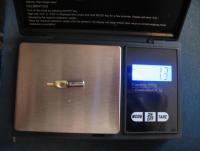
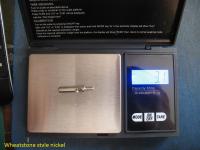
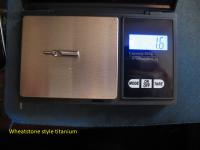
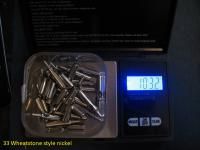
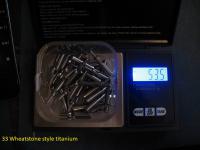
Would it be unethical.......
in Instrument Construction & Repair
Posted
I converted an old 39 lachenal McCann and it is very true that it is only as good as its reeds which were rather average.